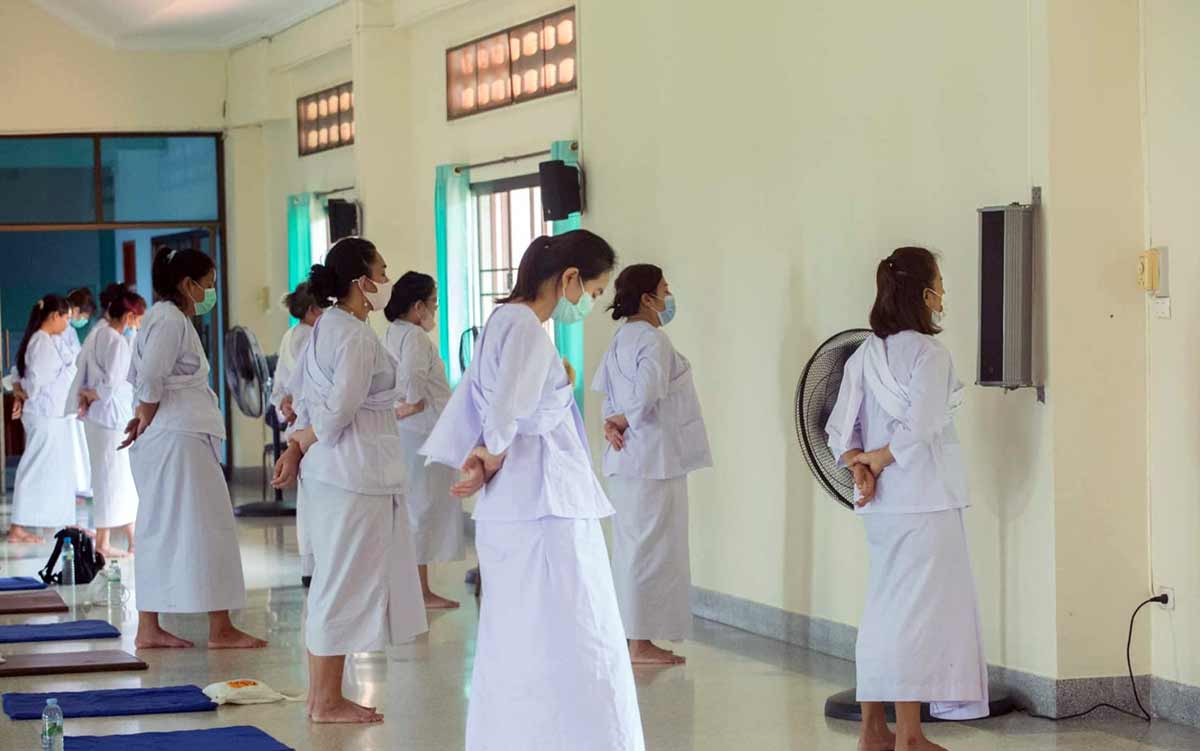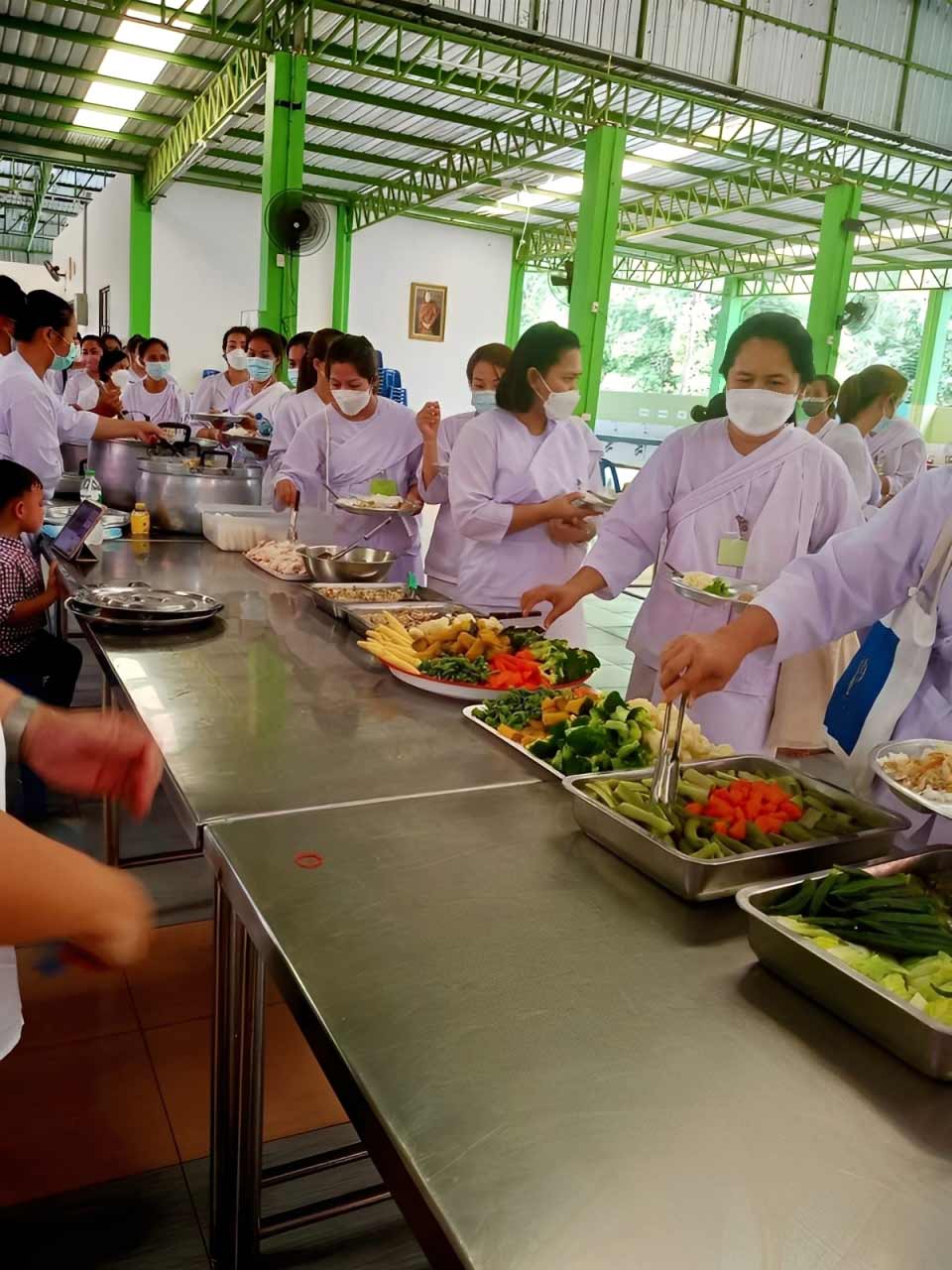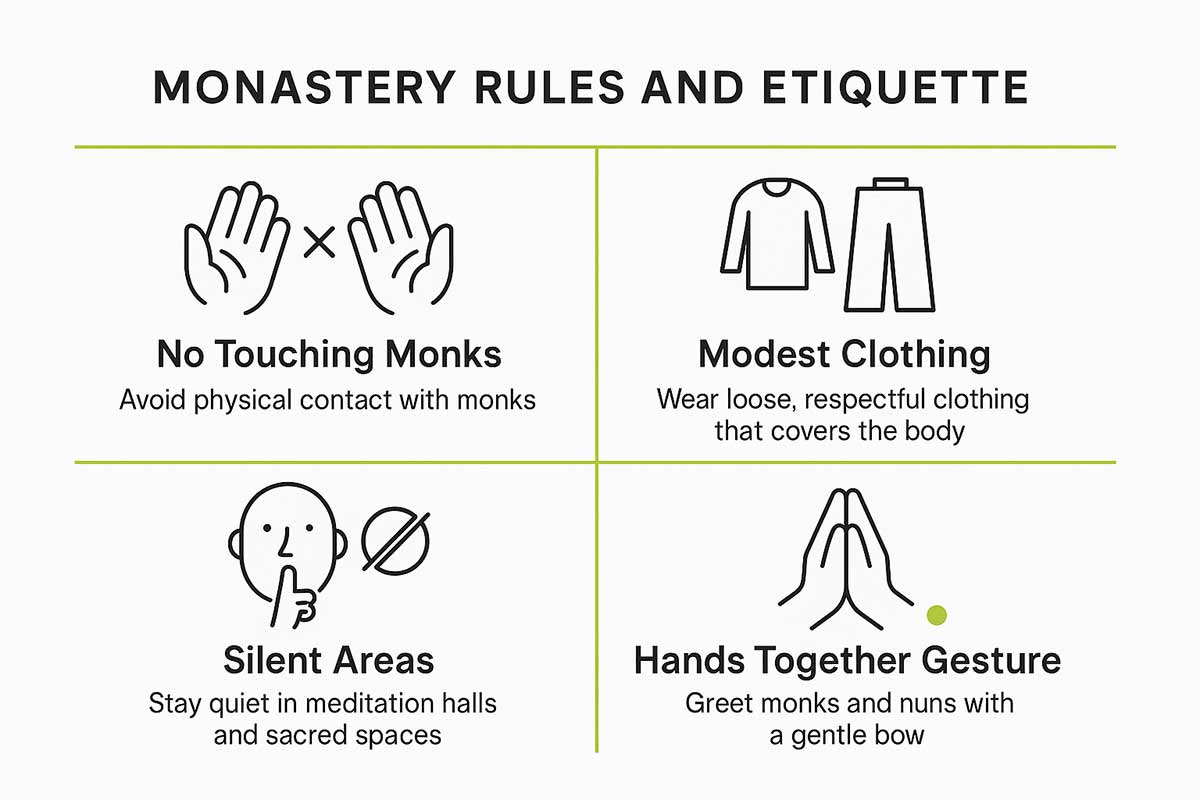How to Prepare for a Monastery Stay: What to Pack, Expect and Practice
Last Updated: November 28, 2025
Tweet

Going to a monastery is not like a usual holiday. It’s a quiet time away from busy routines, phones, and noise. It gives you a chance to slow down, think about yourself, and experience a different way of life.
If you’re coming from North America or Europe to a monastery in Nepal, Sri Lanka, or Thailand, a little planning can help. In this guide, we’ll explain what to pack, what daily life is like, and how to get your mind ready before and during your stay.
Before You Go – Choosing and Booking the Monastery
Most monasteries or meditation centers that welcome visitors from abroad now have an English website or at least an email address. Examples include well-known places like Kopan Monastery in Nepal, Na Uyana or Nilambe in Sri Lanka, and Wat Suan Mokkh, Dipabhavan, or Wat Kow Tahm in Thailand.
- Book 4 to 8 weeks ahead because monasteries fill up fast, especially from December to March when the weather is cool and dry.
- Check the daily donation. It usually costs about US$10–40 each day in Nepal and Sri Lanka. Many forest monasteries in Thailand are technically free, but visitors are expected to give what they can as a donation.
- Visa: Most Western passports allow you to stay in Nepal, Sri Lanka, and Thailand for 30 to 90 days when you arrive or through an e-visa. When you go through immigration, just say you're there for "tourism." You don't need to mention staying in a monastery.
Once your spot is confirmed, ask the monastery about what to wear, when to arrive, and any special rules. Different places may have small differences, but they all value simplicity, respect, and a willingness to learn.
Please click here to get the complete details on available placement, classes, accommodation, cost, visa, airport arrival and the rest of it.
Get More Info Now »
What to Pack for a Monastery Stay
The main idea of packing is to keep things simple, modest, and useful. Monks and nuns live this way, and you are encouraged to do the same while you're there.
Clothing Essentials
- Loose-fitting trousers: Lightweight, quick-drying pants are the best choice. They should be comfortable enough to sit cross-legged. Avoid tight leggings (unless worn under a long top), shorts, or ripped jeans.
- Long skirts or dresses (for women): Long dresses that reach the ankles are best. Many monasteries and temples ask visitors to wear clothes that cover most of the body, especially when going into special places like shrines and prayer halls.
- Long-sleeved tops and t-shirts: You must cover your shoulders all the time while in the monastery. Bring simple T-shirts and light, long-sleeved shirts. Don’t wear low-cut tops, tank tops, or clothing with big logos or slogans.
- Colour choice:
- In Thailand and many Sri Lankan monasteries, visitors who are not monks are often asked or expected to wear white clothes.
- In Nepal, the rules are often more relaxed. You can usually wear light blue, grey, or beige as long as your clothes are modest.
- Scarf or shawl: A shawl or light scarf is very useful. You can wear it on your shoulders, around your waist, or use it as an extra layer when it’s cool.
- Warm layer: In the foothills of Nepal or Sri Lanka's hills, mornings and evenings can be cold from November to February. A simple fleece or warm sweater is enough to stay warm.
- Socks: You will take off your shoes many times a day. Socks are usually allowed in meditation halls, especially if the floors are cold.
Footwear and Day Gear
- Easy-to-remove shoes: Flip-flops or slip-on sandals are almost always needed. You will take them off at every hall, shrine, and sometimes even when entering buildings.
- Sturdy walking shoes: If the monastery covers a big area or is on a hill, wearing simple walking shoes makes it easier to walk on paths, stairs, and short hikes.
- Small daypack: A simple, lightweight backpack is useful for carrying your water bottle, notebook, shawl, and other small things during the day.
Toiletries and Health Items
Keep your personal care straightforward and neutral.
- Unscented toiletries: Use gentle, unscented soap, shampoo, and deodorant. Strong perfumes or colognes can disturb others during meditation.
- Basic health kit:
- Mosquito repellents containing DEET or picaridin are recommended, especially when visiting places like Sri Lanka and Thailand.
- Basic first-aid includes using bandages, treating Diarrhoea, and relieving pain.
- Diarrhea medicine and rehydration salts help treat diarrhea and prevent dehydration.
- Bring extra prescription medicines because pharmacies might be far away.
- Menstrual products:
- Bring enough of your favorite products because some Western brands might not be available.
- In some traditional cultures, women have certain rules during their period, like not going into sacred places. It's helpful to learn these rules before visiting a monastery and to bring a dark cloth or shawl that you can wrap around yourself.
Useful Extras
- Flashlight or headlamp: Power outages happen often, and many monastery paths are dark at night.
- Reusable water bottle: A bottle with a filter or purification tablets can help if you're not sure about the water quality. You can usually get boiled or filtered water, but it's not always available all the time.
- Watch (non-smart): You should keep track of your meditation, chanting, and meals without always looking at your phone.
- Notebook and pen: A basic notebook is good for jotting down lessons, thoughts, and your personal feelings.
- Phone + local SIM: Keep your phone silent and out of sight during activities. A local SIM card can be helpful for emergencies before or after the retreat, but Wi-Fi might be limited or turned off on purpose.
- Passport photocopies + passport photos: Useful for extending your visa or registering locally if necessary.
Please click here to get the complete details on available placement, classes, accommodation, cost, visa, airport arrival and the rest of it.
Get More Info Now »
What to Leave Behind
- Revealing, tight, or flashy clothing.
- Expensive jewellery and accessories.
- Non-essential electronics like laptops, tablets, and speakers.
- Alcohol, drugs, and non-vegetarian snacks are usually not allowed in the monastery.
- Strong perfumes or heavy cologne.
- The lighter and simpler your packing, the easier it is to get used to monastic life.
What to Expect in Monastery Daily Life
Life in a monastery follows a simple daily pattern. It is based on rules for monks called Vinaya and teachings called Dhamma or Dharma. The days are slower than in a city, but they are busy.

The Daily Schedule
A typical day may look like this:
- Very early wake-up (around 6:00–7:00 AM): The monastery wakes up early at sunrise.
- Morning chanting and meditation: Usually, the first activity happens in the main hall, where people chant and then sit quietly.
- Breakfast (around 6:00–7:00 AM): Usually a simple meal, often eaten in silence.
- Work period (karma yoga): You might be asked to do chores like sweeping, gardening, cleaning, or helping in the kitchen. This isn’t extra work; it’s part of practicing mindfulness.
- Dhamma talk or teaching session: A monk or nun may give a short talk or lead a simple reflection on the teachings of Buddha.
- Lunch (around 11:00–12:00): In many Theravada monasteries in Thailand and Sri Lanka, this is the main and sometimes the only substantial meal of the day, especially for monks. Visitors who are not monks may eat light food later, but usually, people follow the local rule of not having heavy meals after noon.
- Personal time: After lunch, you usually have time to rest, read, walk, or practice on your own.
- Evening chanting and meditation: Another group practice session before the evening.
- Lights out (around 9:00 PM): The monastery quiets down, and everyone goes back to their rooms.
The exact schedule differs from one place to another, but early mornings, simple meals, group practice, and periods of silent work are common everywhere.
Accommodation and Facilities

Monastery stays are not luxury retreats. Expect:
- Simple rooms: You can stay in a private small hut, a single-room, or a shared dormitory.
- Basic bathrooms: Shared facilities are common. You might see Western toilets, squat toilets, or both. Hot water may not always be available.
- Simple vegetarian food: Meals are usually vegetarian or vegan, eaten quietly, and made with care. The goal is not to have many choices, but to be thankful for what is offered and to prevent waste.
If you arrive with these expectations, you are less likely to feel disappointed and more likely to feel grateful for what is available.
Rules and Etiquette
Monasteries are places for spiritual growth, not for staying as a hotel. Following the rules is part of your practice.

- Respect for monks and nuns:
- In Theravada countries, monks are called “Bhante” or “Venerable Sir,” and nuns are called “Ayya” or “Venerable Sister.”
- Putting your hands together at your chest in a gentle bow, called Anjali Mudra, is a common way to show respect.
- Modest physical conduct:
- Public displays of affection like hugging, kissing, or touching are not allowed.
- Speak quietly and don't laugh loudly or shout.
- Gender etiquette:
- In many traditions, women do not touch monks, and monks do not touch women.
- When women give something to a monk, they usually put it on a table or cloth instead of giving it directly.
- These rules are based on culture and religion, not personal choices. They help protect the vows of monks and nuns.
- Silence (Noble Silence):
- Some monasteries practice complete or partial silence, especially during retreats.
- You might be told not to speak at some times or in certain places. This quiet is meant to help you focus on your inner work.
If you're not sure about a rule, see what local followers do and ask politely if you can.
How to Prepare Your Mind and Practice
Getting ready for a stay at a monastery isn't just about packing your suitcase; it's also about your attitude.
Please click here to get the complete details on available placement, classes, accommodation, cost, visa, airport arrival and the rest of it.
Get More Info Now »
Before You Arrive
- Practice sitting meditation:
- Spend 10 to 15 minutes each day before your trip.
- Sit on a cushion or a folded blanket on the floor.
- Sit up straight and just breathe normally.
- This will help your body get used to sitting longer later.
- Read basic teachings:
- Learn about the Four Noble Truths and the Eightfold Path.
- You don’t need to be an expert, but having a basic understanding will help you follow the talks and instructions more easily.
- Cultivate an open mind:
- Forget the idea that your stay has to be completely perfect or always calm.
- There will be calm times, but also moments of discomfort and boredom.
- View the experience as an opportunity to better understand yourself, not to run away from yourself.
During Your Stay
- Practice mindfulness (sati):
- Be fully focused on whatever you're doing, like walking, eating, sweeping, or listening.
- When your thoughts start to plan, worry, or complain, notice them and gently bring your attention back to the present.
- Embrace the silence:
- Silence can feel weird at first, especially if you're used to lots of noise or talking.
- Think of it as help, not a punishment. When things are quiet, your mind can understand them better.
- Practice generosity (dana):
- In many Theravada monasteries, teachings are given for free and supported by donations.
- When your visit ends, it’s common to give a donation based on what you can afford. This isn’t a fixed price but a way to help the community that hosted you.
- Ask questions mindfully:
- Most monasteries offer times for questions and answers.
- Now is a good time to ask about your lessons or your practice.
- Ask questions out of genuine curiosity instead of trying to argue.
- Be patient and kind with yourself:
- Your legs might ache, you could feel sleepy early in the morning, and your mind might not want to follow the schedule.
- All of this is normal.
- Instead of fighting yourself, just notice how you react and be patient and gentle with yourself.
Country-Specific Nuances
Nepal, Sri Lanka, and Thailand all have Buddhism in their history, but each one has its own unique culture and traditions.
Thailand
Thailand is mostly Theravada Buddhist.
- Many monasteries, called wats, are used to visitors from other countries and offer organized meditation retreats, including Vipassana.
- Guests often wear plain white clothing.
- The rules for interactions between monks and women are very strict. If you're not sure what to do, always ask and make sure to follow the local customs carefully.
Sri Lanka
Sri Lanka also follows Theravada Buddhism with a very old and rich monastic tradition.
- Some monasteries and retreat centers are located in old or forested areas, like around Anuradhapura or in the hill country.
- The schedule is similar to Thailand: wake up early, chant, meditate, and eat simple meals.
- Dress code is usually modest and often white for lay meditators.
Nepal
Nepal has a mix of Tibetan Buddhism and Hindu traditions.
- Many monasteries in places like Kathmandu, such as in the Kopan or Pullahari areas, or in the Himalayan region, follow Tibetan Buddhist traditions.
- The atmosphere can seem more magical, with prayer flags, long chants, and various rituals.
- Clothing can be more flexible with colors, but you still need to be modest.
In all three countries, being respectful, acting kindly, and wanting to learn are more important than wearing the perfect clothes or having the latest gear.
Please click here to get the complete details on available placement, classes, accommodation, cost, visa, airport arrival and the rest of it.
Get More Info Now »
Conclusion: Preparing for a Simple and Meaningful Monastery Stay
Staying at a monastery isn’t about escaping life, but about experiencing it more calmly and clearly. By packing lightly, knowing the daily routine, and being patient and present, you give yourself a better chance to learn from the experience.
Whether you’re listening to chants in a hall in Thailand, walking through a forest monastery in Sri Lanka, or watching prayer flags sway in Nepal, the real practice is the same: to be aware, kind, and open. If you go with this attitude, your time at the monastery can be a gentle but effective step toward finding peace and clarity inside.
Frequently Asked Questions (FAQs)
Do I need to be Buddhist to stay in a monastery?
Most monasteries that accept visitors from other countries welcome people of all religions or no religion at all. They only ask that you respect their rules, follow the schedule, and stay open-minded.
Do I need meditation experience before I go?
Having some experience, even just 10–15 minutes daily for a few weeks, can be helpful. Many monasteries are accustomed to beginners and will guide you thoroughly.
How long should I stay for a first visit?
If it's your first time, spending 5 to 10 days is usually enough to experience monastic life without feeling overwhelmed. If you enjoy it, you can always come back for a longer retreat later.
Is it safe to stay in a monastery as a solo female traveller?
Every year, many women from Europe and North America stay in monasteries in Nepal, Sri Lanka, and Thailand. These monasteries are usually very safe because they have clear rules and boundaries. To stay safe, pick a well-known monastery, follow its rules, and tell family or friends where you are.
To share this link:
Please click here to get the complete details on available placement, classes, accommodation, cost, visa, airport arrival and the rest of it.
Get More Info Now »


